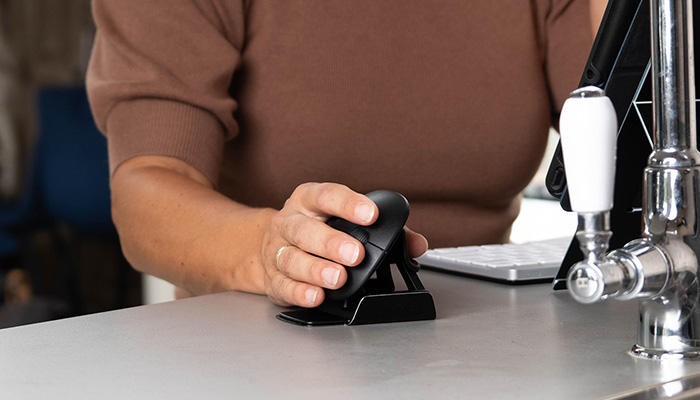
Healthy workplaces make healthy employees. More and more companies realise the importance of this. After all, a lower risk of RSI complaints also means: less absenteeism. As a consultant, it is important that you have enough knowledge of ergonomics to be able to help clients. In this blog post, we will therefore take a closer look at the differences between the normal and the ergonomic vertical mouse.
Normal mice
The traditional mouse: the most commonly used input device when working with the computer. However, when using such a standard mouse, the hand and wrist are in an unnatural position. You imperceptibly make small, stressful movements from the wrist and this can quickly lead to overload. But which movements exactly cause this strain?
Causes of RSI
Scientific studies frequently cite the following 3 factors as major causes of RSI complaints:
Pronation: turning the forearm.
With a normal mouse, the forearm has to rotate to place the palm of the hand facing downwards on the mouse. This creates an unnatural posture, and therefore continuous strain on the forearm muscles.
Ulnar and radial deviation:
Rotational movements from the wrist. In addition, you mainly move the hand, where repeated movements can overload the tendons in the wrist.
Dorsal flexion:
A lifting movement of the hand. To properly place the hand on and around a standard mouse, it must be lifted slightly from the wrist, making the hand angle with the forearm. This causes continuous strain on the forearm muscles and tendons running through the wrist.
It is very difficult to unlearn the learned way of mousing. That is why it is smart to switch to an ergonomic mouse that is designed to make you mouse healthily in a natural way. Even if you do not (yet) have RSI complaints
Vertical mice
An alternative to the normal mouse is the vertical mouse. With a vertical mouse, you don’t have to rotate the forearm, preventing overload due to pronation and dorsiflexion of the wrist in one fell swoop. Due to the vertical position of the hand, it is no longer possible to move the mouse from the wrist; thus, ulnar and radial deviation are also eliminated. You automatically move the mouse more from the entire arm.
So almost every vertical mouse helps to use the large arm muscles, instead of the small muscles and tendons. However, there are still many differences between vertical mice. In this respect, one mouse cannot necessarily be called the best; choosing the right ergonomic mouse is also personal and depends, among other things, on the size of your hand. Vertical mice come in all shapes and sizes, so there is always a suitable one.
Want to know more?
Besides normal and vertical mice, there are some other ergonomic alternatives, such as central mice and trackball mice. You can read more about these options, and the science behind them, in our white paper. With it, we will help you give well-founded advice!


